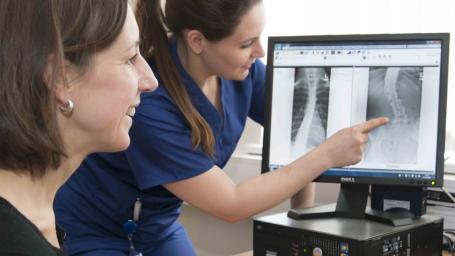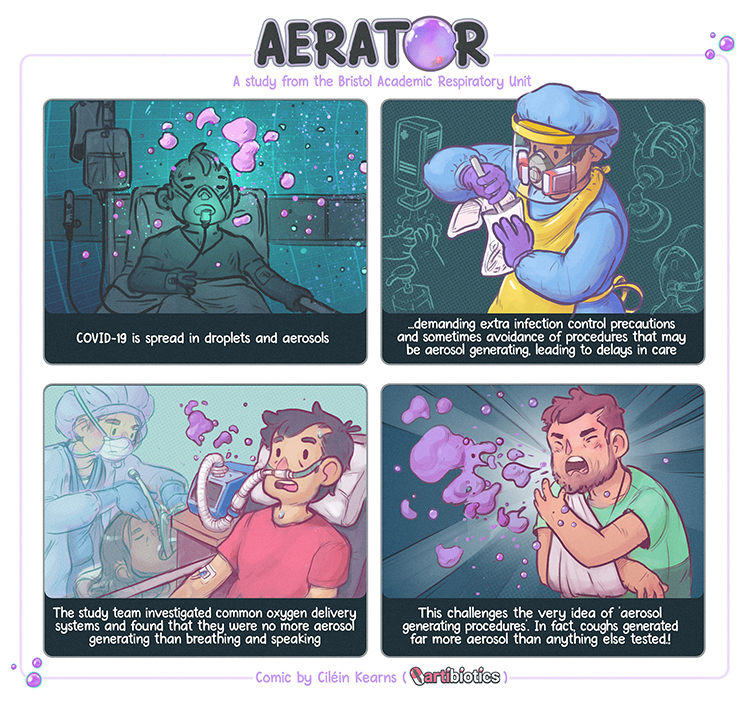The AERosolisation And Transmission Of SARS-CoV-2 in Healthcare Settings (AERATOR) study aims to rapidly study the amount and type of aerosol generated when medical procedures are performed, and how infectious this aerosol is.
Aerosol generation occurs when tiny droplets of liquid are suspended in the air. Aerosols can be generated during many medical procedures. Some procedures might produce more aerosols than others, and droplets of different sizes, but this is largely unknown at the moment. However, aerosols can carry viruses, like coronavirus, which risks further infections if inhaled by healthcare staff or other patients.
Many medical and surgical guideline groups have made decisions that certain procedures are aerosol generating, based on limited or no evidence. As a result, many procedure lists have been cancelled or are being performed with authorised delays between procedures and full PPE for staff. These delays can add more than 30 minutes to routine procedures such as cataract surgery, pulmonary function tests, and joint replacement surgery, reducing capacity at a time when the NHS is facing a huge backlog that will have an impact on patients.
The AERATOR study will be carried out using specialist equipment in operating theatres and wards to measure real-life aerosol generation in five clinical settings: dental, orthopaedic, respiratory, critical care and ophthalmology. By using specialist equipment, only available at the University of Bristol, the research team will also investigate how long coronavirus survives while airborne and how environmental conditions impact on the infectivity of the virus.
The research will also advise guidelines on the appropriate level of PPE for staff, as well as the length of time aerosol is present for and how it spreads in a real-world clinical setting.
Nick Maskell, Professor of Respiratory Medicine at NBT and Bristol Medical School: Translational Health Sciences (THS), and principal investigator for the project, said:
“A systematic improvement of the evidence would then allow procedures that are truly low risk to go ahead without the need for patient testing, air-cycling protocols or extensive PPE. Our study will ensure that higher risk procedures are performed efficiently in the appropriate clinical settings and without risk to staff or patients.
Given how often these routine procedures are performed across the NHS, even a small improvement in efficiency will have a vast impact on clinical services, waiting times and costs.”
Jonathan Reid, Director of Bristol Aerosol Research Centre and Professor of Physical Chemistry in the School of Chemistry at the University of Bristol, and co-investigator on the project, added:
“We hope our research will show how best to organise operating theatres, medical procedures, out-patient clinics, wards and use of PPE, in order to protect patients and staff while maximising the ability of the NHS to resume life-saving work.”
The research findings will help inform hospital trusts, policy makers and Public Health England about the safe reopening of essential NHS services.
The project ‘AERosolisation And Transmission Of SARS-CoV-2 in Healthcare Settings (AERATOR)’ is funded by a grant award of £433,000 from the National Institute for Health Research (NIHR) and UK Research and Innovation (UKRI) COVID-19 rapid response initiative. The 12-month study will run until August 2021.
Study Results:
Aerosol emission from the respiratory tract: An analysis of relative risks from oxygen delivery systems
New research from the AERATOR study suggests that respiratory support used to treat patients with severe COVID-19 is associated with less aerosol emission than breathing, speaking or coughing.
In August 2020, the AERATOR group was awarded an NIHR-UKRI grant to study a range of potential aerosol generating procedures (AGP's) commonly performed across the NHS. Currently policies around these procedures mean the use of full (FFP3) PPE and often lengthy waits between procedures to allow for cleaning and adequate room airflow changes to occur. This has led to increased waiting times and the cancellation of some NHS services across the UK. AERATOR 'AERosolisation And Transmission Of SARS-CoV-2 in Healthcare Settings' has received urgent public health (UPH) priority to support the research team to rapidly deliver the study.
Nick Maskell, Professor of Respiratory Medicine at Bristol Medical School: Translational Health Sciences (THS) and NBT, and chief investigator for the study, said:
"It is amazing that in just six months after accepting this award, we are able to share our first set of results on respiratory support. This is a great collaborative effort between experts at the the Bristol Aerosol Research Centre (BARC) and a range of specialists at North Bristol NHS Trust."
Jonathan Reid, Director of Bristol Aerosol Research Centre (BARC) and Professor of Physical Chemistry in the School of Chemistry at the University of Bristol, added:
"Aerosols and droplets are the primary vehicle for transmitting the coronavirus. Measuring how much aerosol is generated by clinical procedures, compared to breathing and coughing, is a crucial first step to identify which processes could pose a risk of infection to clinicians and patients."
Risk of generating aerosols from SARS-CoV-2 directly informs an organisation about acute healthcare and PPE guidance. Continuous positive airway pressure (CPAP) and high-flow nasal oxygen (HFNO) are widely used for oxygen delivery and respiratory support for patients with severe COVID-19, and both are considered high-risk aerosol generating procedures. However, very little is known about the aerosols produced during oxygen delivery and respiratory support.
The AERATOR study team looked at whether oxygen delivery systems, CPAP and HFNO, used routinely on medical wards and intensive care units, generate aerosols. Healthy volunteers were recruited to breathe, speak, and cough in ultra-clean, laminar flow theatres followed by using oxygen and respiratory support systems. Aerosol emission was measured using two methodologies, simultaneously. Hospitalised patients with COVID-19 were also recruited and aerosol emissions measured during breathing, speaking, and coughing. This is the first-time measurements from both healthy volunteers and COVID-19 patients have been taken.
The study team found in healthy volunteers, CPAP is associated with less aerosol emission than breathing, speaking or coughing. Aerosol emission from the respiratory tract does not appear to be increased by HFNO. Although direct comparisons are complex, coughing appears to generate significant aerosols in a size range compatible with airborne transmission of SARS-CoV-2. As a result, the risk of SARS-CoV-2 aerosolisation is likely to be high in all areas with COVID-19 patients.
Dr Florence Gregson, Visiting Research Associate in the School of Chemistry and Dr Fergus Hamilton, Honorary Research Fellow in the Bristol Medical School: Population Health Science (PHS), and joint first authors on the study, explained:
"Using state of the art sampling techniques, and a laminar flow theatre to reduce background aerosol, we measured the amount of aerosol generated when breathing, talking and coughing whilst wearing a surgical mask, continuous positive airways pressure (CPAP) mask or high flow nasal oxygen (HFNO)."
Dr James Dodd, Consultant Senior Lecturer in Respiratory Medicine at Bristol Medical School: (THS) and NBT, and senior author on the respiratory area of the study, said:
"We were delighted to work with world-leading aerosol scientists to design and deliver this study which provides much needed, high quality data on the risk of aerosol emissions when caring for patients with severe COVID-19.
Our study has shown that the use of CPAP actually reduces aerosol transmission rather than increases it. Although direct comparisons are complex, cough appears to generate significant aerosols in a size range compatible with airborne transmission of SARS-CoV-2. This will inform policy makers on appropriate PPE and ventilation in different hospital settings and ultimately how we can best protect our patients and staff."
The findings from the study have been presented to the NIHR Aerosol Generating Procedures (AGP) Task and Finish Group that feeds into the AGP subgroup which reports to SAGE. The AERATOR team hope these results will assist in updating central policies on the use of PPE in hospital settings.
To find out more about the study’s findings, read the full pre-print report.
Please note this is a preprint, so it is a preliminary piece of research that has not yet been through peer review and has not been published in a scientific journal – so this is early data.
Study Visual Story:
AERATOR: A study from the Bristol Academic Respiratory Unit
Thank you to all of our research teams who are making such a different to people’s lives, and also to Southmead Hospital Charity which is raising much-needed funds for COVID-19 research.
Take Part in Research

Become one of the thousands of people taking part in research every day within the NHS.
Contact Research
Research & Development
North Bristol NHS Trust
Level 3, Learning & Research building
Southmead Hospital
Westbury-on-Trym
Bristol, BS10 5NB
Telephone: 0117 4149330
Email: research@nbt.nhs.uk


